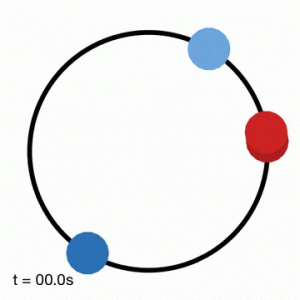Oxford Mathematician Christian Bick talks about his and colleagues' research into oscillator networks and how it could be valuable in understanding diseases such as Parkinson's.
"Many systems that govern crucial aspects of our lives can be seen as networks of interacting oscillators. On a small scale, for example, the human brain consists of individual cells that can send bits of information to each other periodically. On a large scale, the power grid of an entire country can be seen as a network of rotating units (generators and motors). The function of these oscillator networks crucially depends on how the units evolve together. For a power grid to be stable it needs to be synchronized to a common grid frequency—think of the 50Hz coming out of your power outlets at home. By contrast, too much synchronization in the brain is believed to be detrimental as it has been associated with a range of disorders such as epilepsy and Parkinson’s disease.
Synchronization, where distinct units will behave in the same way as time goes on, can arise spontaneously in networks of interacting oscillators. Already Christian Huygens noticed in 1665 that two of his oscillating pendulum clocks showed an “odd kind of sympathy” when they were allowed to interact: they would swing in unison after some time. Mathematical models can help understand how network interactions—the coupling between oscillators—allow for synchronization to arise in oscillator networks.
In contrast to synchronized dynamics, we are interested in networks where identical oscillators can show distinct dynamics in the following sense. Take a collection of oscillators which would oscillate at the same frequency in isolation. Now when you make these oscillators interact in a particular way, then half of the oscillators will be oscillating at one frequency while the other half is oscillating at another frequency! In other words, there is a separation of frequencies that purely arise due to the network interactions. In work with collaborators at St. Louis University we studied this phenomenon in a network of four oscillators. We first analyzed the effect in a mathematical model. Guided by the theoretical work, we then demonstrated the same effect in an experimental setup of electrochemical oscillators with suitable network interactions.
Our results shed further light on the effect the network structure has on the dynamics of interacting oscillators. In particular, they indicate what network interactions allow for dynamics where only part of the oscillators are synchronized in frequency. Hence, if neural disease is indeed related to abnormal levels of synchrony, these insights could, for example, be useful in devising means to prevent or counteract pathological synchronization (as in Parkinson's disease) by tuning the network interactions."


